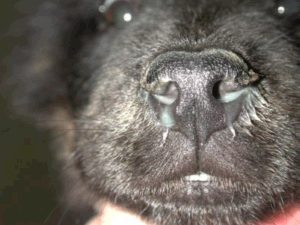|
|
What is Distemper?Canine Distemper
Most of us have heard of distemper infection for dogs and gather it is very bad.
The typical distemper suspect is a rescue or pet store dog or puppy, usually with questionable vaccination history or an as yet incomplete vaccination series. The dog or puppy has been housed with other rescue dogs. Symptoms begin with:
Seizures (classically starting with snapping or tremoring of the jaws that progress to convulsions of the whole body. This distemper classic sign is called a chewing gum fit.)
This means that the dog appears to recover only to break with neurologic disease 1 to 3 weeks later. Younger puppies or individuals with weak immunity often die during the mucosal phase while stronger individuals may have relatively mild mucosal signs and not appear ill until the neurologic phase strikes. The canine distemper virus is closely related to the human measles virus and, in fact, in older times, puppies were immunized for distemper with vaccine against measles. It has been said that a child in the home of a dog vaccinated with live distemper virus vaccine will become exposed to the virus and immunized against the measles (though we do not recommend such experiments at home). The distemper virus consists of a single strand of RNA, encased in a protein coat which is again encased in a fatty envelope. This sounds esoteric but the fatty envelope makes all the difference in the world. The fatty envelope is easily disrupted in th e environment which makes it impossible for infectious virus to persist in the environment. Because an intact fatty envelope is required for infection, virus transmission must involve dog to dog contact or at least contact with extremely fresh (less than 30 minutes old at 60 degrees and up to 3 hours oldat room temperature) infected body secretions. As with other viruses, living virus happily freezes and can survive for years if kept frozen and protected from light. Routine disinfection and cleaning readily kills the distemper virus in the kennel setting. TRANSMISSION AND INFECTIONThe infected dog typically infects other dogs via coughing infected respiratory secretions though the virus is shed in most other body secretions including urine. The virus enters the new host via the nose or mouth and promptly begins to replicate. Virus is engulfed by cells of the immune system called “macrophages.” The idea is that the virus will be engulfed, walled off within the cell and then destroyed by enzymes. Unfortunately for the new host, this process does not damage the virus as intended; instead, the virus is able to use the macrophage as a means of transportation through the host’s body. Within 24 hours, the virus has traveled to th e lymph nodes of the lung. By the 6th day, the virus has migrated to the spleen, stomach, small intestine, and liver. Fever is developing at this point. By day 8 or 9 an important crux is reached in the timetable of infection. The host is mounting an immune response during this time and the outcome depends on how fast and how well this is accomplished. A strong immune response begins to clear the virus at this point and has eliminated all traces of virus with no symptoms of illness by Day 14. A weak immune response allows the virus to reach the ”epithelial cells,” the cells which line every interface the body has with the outside world. The tender epithelial cells lining the chambers of the brain are infected as well. The host begins to get sick as the virus spreads but as the host's immune response grows symptoms wane. This phenomenon accounts for the wide variability in symptoms; some dogs get only a few mild symptoms while others get a full lethal combination. After clearing from most internal organs, the virus is able to “hideout” for long periods of time in the nervous system and skin. Because of this phenomenon, callusing of skin or, much worse, seizures may occur long after the infection was thought to be cleared. Most victims in the U.S. are puppies. (The colostrum suckled in the first day or so of life will provide them with a solid reflection of their mother’s immunity. This will have waned by age 16 weeks leaving the puppy vulnerable if vaccines have not been administered for further protection. In our society most mother dogs will have received some form of vaccination and thus be able to pass on at least some immunity and will have some ability to protect herself. In societies where vaccination is not common, distemper attacks all age dogs.) CONFIRMING THE DISTEMPER INFECTIONAs if it is not bad enough that this infection has a poorly defined endpoint so one never knows for sure one is “out of the woods,” it is almost impossible to confirm a distemper diagnosis. Because of this, distemper is a “clinical diagnosis” which means that rather than confirming infection with a test that is negative or positive, the veterinarian must look at the whole picture: what symptoms are there, is the history typical, etc. The virus itself remains elusive so that positive test results are meaningful in confirming the infection, but negative results=2 0do not rule it out. The following are tests that can be used: TREATMENT FOR DISTEMPERMany bizarre protocols have emerged over time as we grope for meaningful anti-viral therapy. The fact remains that recovery from distemper is all about immunity and the only real treatment is supportive care while the patient mounts its own immune response. If the patient has pneumonia, antibiotics are used on the secondary bacterial infections. Airway dilators are used as needed. Physical therapy is used to promote cough. If the patient has diarrhea, intravenous fluids are used to prevent dehydration etc. Distemper is extremely variable in its ability to produce symptoms and recovery occurs at any stage. This has led to assorted therapies being credited with effect when what was more likely witnessed was the natural removal of the infection by the host’s immune system. Neurologic distemper is particularly difficult to treat. Still, it is possible for dogs to recover with livable deficits even from neurodistemper; euthanasia is best left for progressive, incapacitating neurologic symptoms. |
|
|
|
© 2010-2016 Shiba-Puppies.com • All Rights Reserved • www.Shiba-Puppies.com Fair Use Notice: This site may contain copyrighted material whose use has not been specifically authorized by the copyright owners. We believe that this not-for-profit, educational use on the Web constitutes a fair use of the copyrighted material (as provided for in section 107 of the US Copyright Law). If you wish to use this copyrighted material for purposes of your own that go beyond fair use, you must obtain permission from the copyright owner. |

















 The basic vaccine
for dogs is “the distemper shot,” which vaccinates against distemper, parvovirus and some minor kennel
cough agents. Luckily, this is all most people ever hear of distemper. If you are reading this, however,
you probably have a dog that is suspected of having this dreaded infection.
The basic vaccine
for dogs is “the distemper shot,” which vaccinates against distemper, parvovirus and some minor kennel
cough agents. Luckily, this is all most people ever hear of distemper. If you are reading this, however,
you probably have a dog that is suspected of having this dreaded infection.